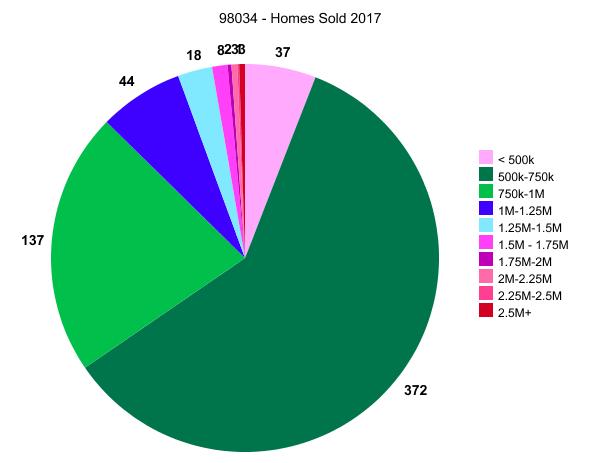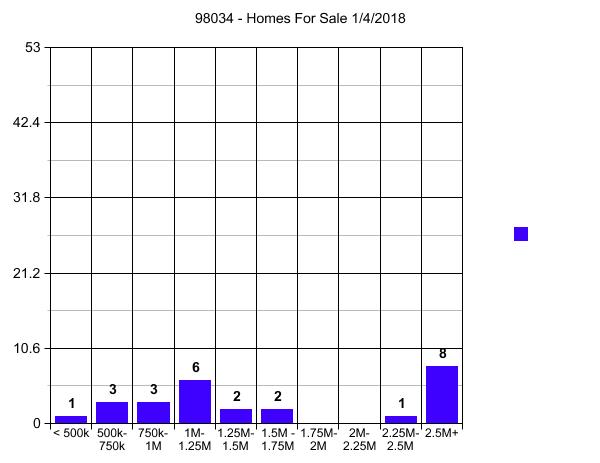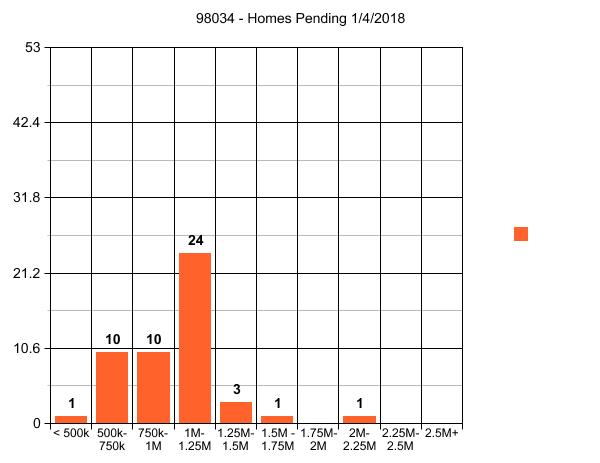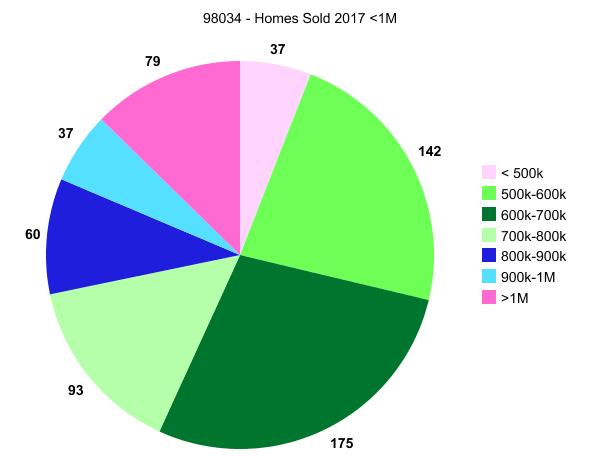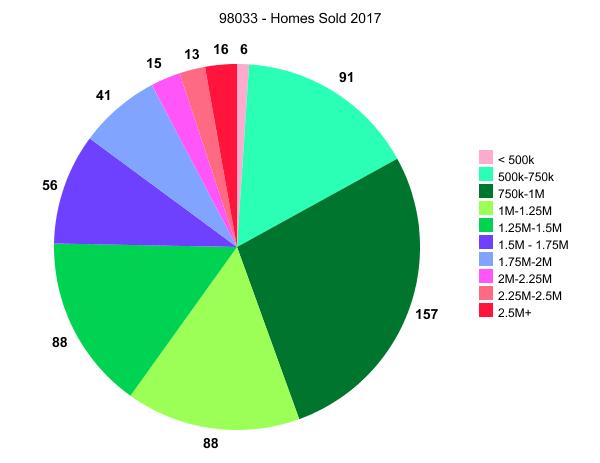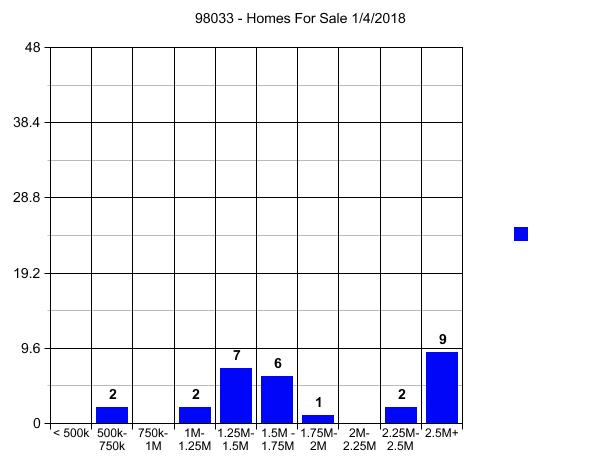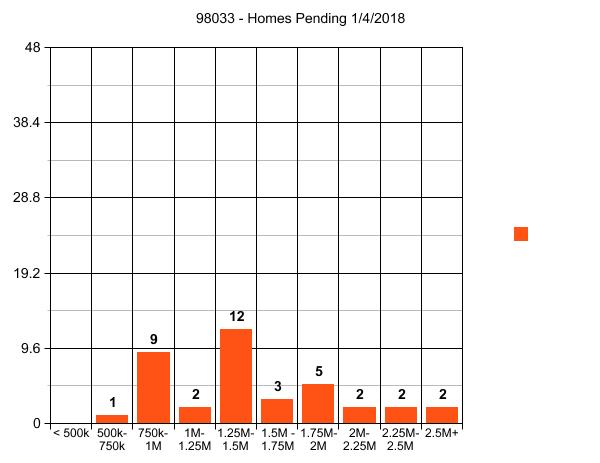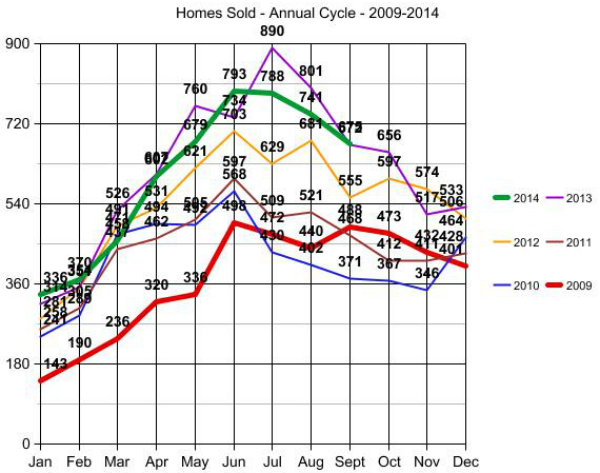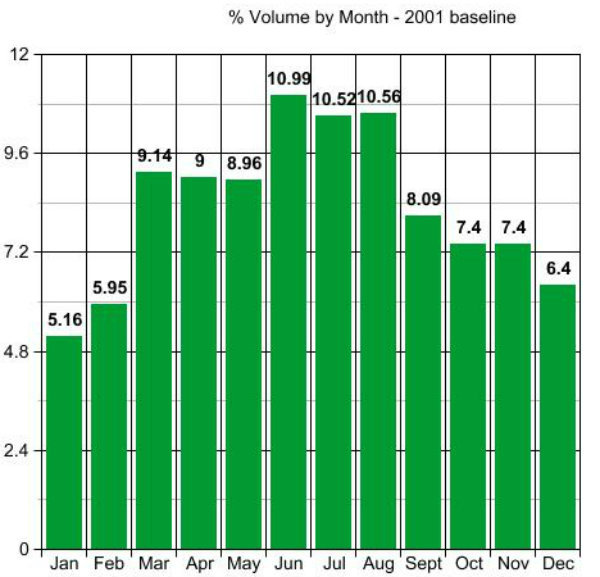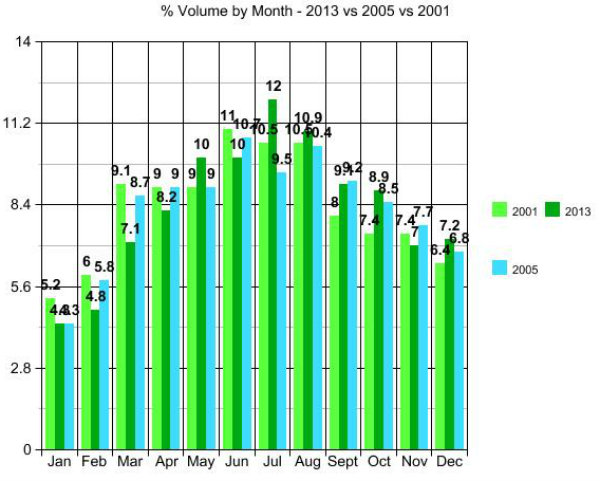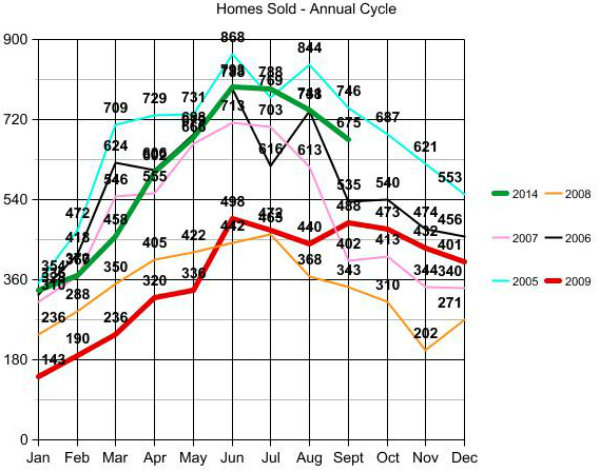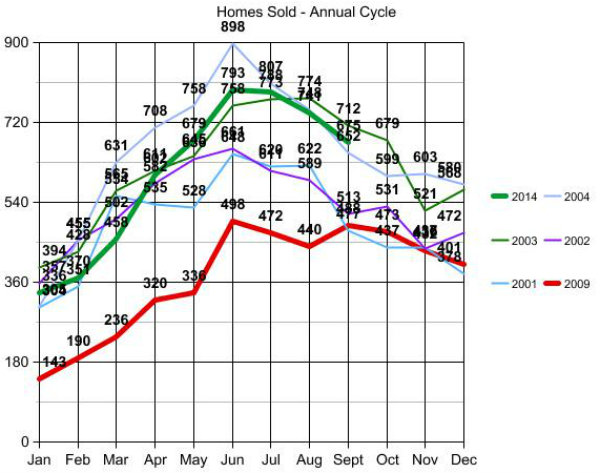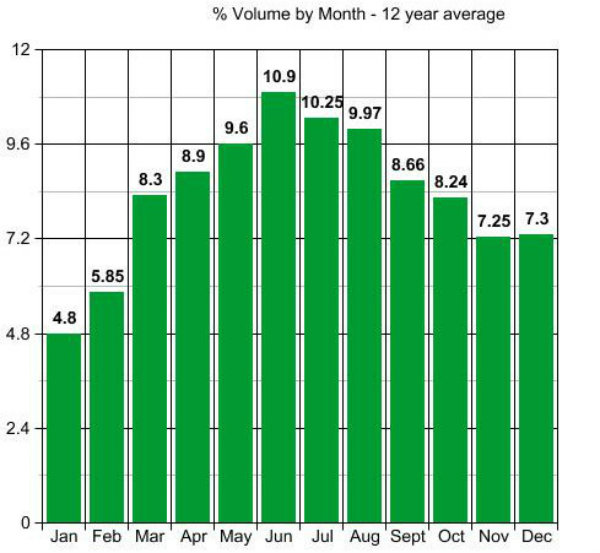First the graphs…
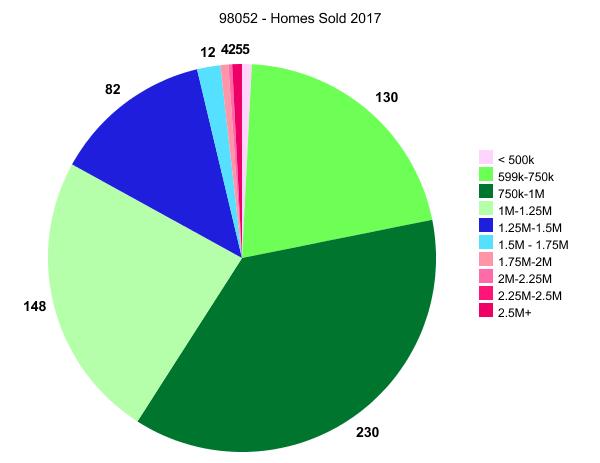

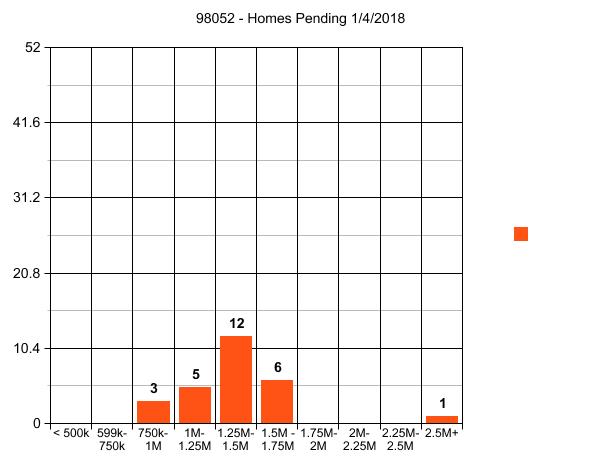 2018 Home Prices in Kirkland 98033
2018 Home Prices in Kirkland 98033
2018 Home Prices in Kirkland 98034
Category Archives: Seattle Real Estate Guide
2018 Home Prices in Kirkland 98034
Again, similar to my 98033 post earlier today, there is nothing for sale and not unusual for this time of year. The height of the For Sale and Pending graphs is the average # of homes sold in one month based on 2017 sales IF every month were the same. In 2018 in 98034 it will still be the same “what’s new this week” with everything coming on being sold in a week or less unless it is overpriced.
The main reason for me to post these by zip code snapshots this time of year is for people who need to know where they can afford to live. In that regard, Kirkland 98034 is much more affordable than Kirkland 98033. So when you say you want to live “in Kirkland”, not that by price point you may mean what is sometimes called “the other Kirkland”.
Again, I have coded the more likely price ranges in green tones. But given compared to 98033 the green tones in 98034 all bulk up between $500k and $1M, much unlike 98033 Kirkland, I have added a 2nd pie chart breaking the affordable prices into smaller, 100k, segments.
The big NEWS segment of these 98034 stats is that a large number of pending sales are in the $1M to $1.250M range. Only 44 SOLD in the price range in 2017, but ore than half of the current pendings waiting to close (mostly if not all new construction) are in this price range.
The DOW just went over 25,000 this morning and there is no product for sale. Expect another big climb in prices in the first half of 2018.
More Zip Codes to follow in subsequent posts. Some will be Eastside and some will be Seattle, but only in places where I work, so mostly North of Downtown in Seattle plus Shoreline, Kirkland-Bellevue-Redmond, Issaquah-Sammamish and bit of Bothell on The Eastside.
ARDELL DellaLoggia, Sound Realty – 206-910-1000 cell – ardelld@gmail.com email
Required Disclosure: Stats in this post are hand calculated by ARDELL in Real Time and not compiled, verified or published by The Northwest Multiple Listing Service.
Related Post 2018 Home Prices in Kirkland 98033
2018 Home Prices in Kirkland 98033
Of course there is nothing for sale, but not unusual for this time of year. The height of the For Sale and Pending graphs is the average # of homes sold in one month based on 2017 sales IF every month were the same. In 2018 in 98033 it will still be the same “what’s new this week” with everything coming on being sold in a week or less unless it is overpriced.
The main reason for me to post these by zip code snapshots this time of year is for people who need to know where they can afford to live. For instance if you want to buy a house vs a condo and you want to spend less than $500,000, now you know that only 6 properties sold in all of 2018 for less than $500,000, so you may be barking up the wrong tree in 98033. I will try to post this same data for the zip codes where I work, today if possible, to keep everything on an even keel.
I have coded the more likely price ranges in green tones, the not likely ones in red tones (but somewhat more for sellers than buyers) in the pink-red and the yes, but be discerning please, are blue.
That inventory is non-existent should not be a surprise to anyone. Only FOUR houses for sale under $1.25 Million might be a bit surprising to some and NONE under $500,000 might be a surprise to some before reading this post and viewing the first graph.
The DOW just went over 25,000 this morning and there is no product for sale. Expect another big climb in prices in the first half of 2018.
More Zip Codes to follow in subsequent posts. Some will be Eastside and some will be Seattle, but only in places where I work, so mostly North of Downtown in Seattle plus Shoreline, Kirkland-Bellevue-Redmond, Issaquah-Sammamish and bit of Bothell on The Eastside.
I posted the Pending sales as well so that people can see what recently sold but didn’t close yet. Not quite as bad as the For Sale stats, but still pretty dismal…or GREAT!…depending on whether you are a buyer or a seller.
ARDELL DellaLoggia, Sound Realty – 206-910-1000 cell – ardelld@gmail.com email
Required Disclosure: Stats in this post are hand calculated by ARDELL in Real Time and not compiled, verified or published by The Northwest Multiple Listing Service.
Related posts 2018 Home Prices in Kirkland 98034
Moving to Seattle from the East Coast
Everyone who is buying a home comes to the marketplace with some preconceptions as to how things will proceed. If someone is selling a house in the area and buying a different house in the same area, there are not as many surprises that cause a lot of confusion. If someone is moving here from California, the process of buying a home is not different and the home styles are often so completely different that the expectation of what they will find is not carved in stone.
When someone is moving here from the East Coast, especially the Northeast, there are a few differences best known before you head out to buy a house.
1) THE HOUSES ARE DIFFERENT
The main difference in the home style is what is called “Craftsman” style. If you are building a house, they often will ask “Traditional or Craftsman?” when asking for the main styling of all of the millwork in the house. While “Traditional” will resemble an East Coast Colonial style a little bit…”traditional” does not mean “colonial”. The floor plan may or may not be different, but the facade will definitely be different.
The four homes in the photo are basically new homes by the same builder with the two on the left being on the East Coast and the two on the right being in The Seattle Area.
Some of the main differences:
1) Wood or wood facsimile products vs Brick A lot of people moving here from other States and other Countries like the more solid look of brick. But know that one of the reasons this area avoided brick for the most part is due to earthquake activity. Wood has some flexibility. Brick and mortar joints do not. There are plenty of old brick tudors still standing that have been through earthquakes. But I have seen many where there are patches over time from the brick cracking in a step pattern. I had some pictures in my phone of a house over in Montlake with this issue recently. If you do buy a brick house, examine it carefully, not just for cracks but for sections where the mortar is wider and often in a step pattern. Do use a structural engineer in addition to or as the home inspector as well. The new homes the brick is just a “facade” and not part of the construction. Still, brick doesn’t move well, even to a small degree.
That said, many of the homes today are built with a wood-like cement product as the siding. More expensive and custom homes still use wood. But most tract homes use the wood-facsimile product that may not have more movement than brick. You just don’t have to deal with the mortar issues.
2) Shutters Most of the time you will feel like the shutters are missing. Often, especially when buying older homes of the exact same style you can find on the East Coast, people will remark that they need to add shutters. Colonial homes had shutters going back centuries of the type shown on the homes in the photos on the left. Once in awhile you will find a form of shutters here that are more of a tudor style shutter. Same with the uneven pitched roof on the bottom photo on the right. There is a tudor influence. But no shutters has been more common for a very long time and because the homes were built that way it may not be easy to add them.
3) Closing and Closing Day
ALMOST NEVER DO YOU MOVE ON THE DAY OF CLOSING ON THE WEST COAST. NOR DO YOU TAKE OFF ANY TIME FROM WORK ON CLOSING DAY.
This has always been the most significant difference in the process, and one that often confuses people who are buying homes.
DO NOT MAKE ANY ARRANGEMENTS FOR MOVERS OR ANY OTHER SERVICES FOR CLOSING DAY!
This is vastly different from the East Coast where closings happen all day and several times in a day, usually every hour or so.
Whether or not you are moving here from the East Coast, it does seem a bit odd for the seller to be signing over his house to a buyer before it is paid for. It also seems a bit odd to sign all of your closing paperwork as the buyer and even bring your funds to closing, and not get the keys to the house. Even more odd that the day of closing is not the day you can tell your movers to bring your belongings to your new house.
The difference is that on the West Coast (and several other States) “closing” means the County has actually recorded the Deed to the property in the buyers name. On the East Coast that is not the case and the Deed is often recorded “in due course” and sometimes a month or so after closing. HUGE difference. On the East Coast they do a table funding and the buyer and seller are often in the same room with the agents and the closing agent. They buyer brings their money, the lender sent the money early in the day, the seller gets a check and hands over the keys to the buyer. All that within one hour. So if the signing is at 10 you can usually have the movers start moving things in around noon. If your closing is at 1 you can usually have the movers ready to move things in by 3 ish.
NOT so on the West Coast. On the West Coast the seller sometimes signs the new Deed over to the buyer a couple of weeks before closing. The buyer most often signs a few days before closing. Closing Day is too late to do much of anything. If it all wasn’t done before Closing Day, or at least most of it, less likely it will close by end of day. Closing is a phone call saying “we have recording numbers”. That means the new Deed has been recorded in the buyer’s name and that usually happens between 4 and 5 p.m. (not always; but often)
BUT! KEYS ARE NOT DUE UNTIL BY 9 P.M.
Once in awhile the seller is not completely moved out by the time that phone call comes in. Technically they have until 9 p.m. to be vacated and hand over the keys. I have only seen it go all the way to 9 p.m. a couple of times in a dozen years. But neither is it practical to want the keys to the house as soon as you get the phone call that it is closed.
The Seller gives the keys to their agent. Their agent gives the keys to the buyer’s agent. The buyer gets the keys from their agent. Most always the Agent for the Buyer can’t get the keys until after it closes. There are a dozen different ways we arrange this depending on the agents and parties, but do know that having cleaners or movers standing outside the door at 5:30 p.m. can end very badly.
Things are changing a bit because of the new rules that lenders must follow as of October 3rd. We are seeing more table funded loans and more buyers signing the morning of closing. We can’t move to a system where all buyers sign the morning of closing. It just wouldn’t work for the Title Companies.
As a buyer you don’t get much notice as to when you will be signing. More and more people are paying an extra cost for a mobile signer so they can sign after business hours or very early in the morning before work.
Just know that Closing Day on the West Coast is very, very different and once your loan documents get to escrow, there will be a signing appointment scheduled with very little advance notice. It’s a bit chaotic, but, it’s just how it is done here.
If you have moved here from the East Coast and have some other observations as to the differences, do note them in the comments along with where you moved here from.
Is Quill Realty the Only non-MLS Broker in Seattle?
Updated 9/13: Quill Realty is now Added Equity Real Estate – but everything else is as true today as when I wrote it! 🙂
I am loving life at the forefront of change in the real estate industry. My firm Quill Realty left the Northwest Multiple Listing Service on July 1. Since then, we’ve picked up some listings and sold a few houses – our first non-MLS sale closed Friday. Congratulations to this beautiful family!!! 
So we’re selling houses at a dramatically reduced cost to our seller clients. In other words, the model appears to be working. Exciting times!
But it begs the question: Is Quill the only non-MLS broker in Seattle? Or are there others, such that a synergy might begin to build. To date, I have yet to find one. I even have a friendly wager with a title representative. He knows lots and lots of people in the local industry, and so far he’s struck out.
Is that right? Is Quill the only voice calling for change in the MLS-bound wilderness? If you know of any others – in Seattle, or Western WA, or even the USA – I’d love to hear about them. Please leave a comment, and thanks much.
The Future of Real Estate? It Arrived Today
I could not be prouder today. Quill’s first Single Broker Listing is live and looks great! On the Quill Blog, on Zillow, on Redfin – heck, it looks great EVERYWHERE!! By my estimation, this is what the future of real estate will look like: One broker marketing a property directly to buyers via multiple channels, without offering to pay the buyer’s agent’s commission (so no MLS number). Exciting times here at Quill!!
Why I am Withdrawing from the Multiple Listing Service to Offer Single Broker Listings
Today, my real estate firm Quill Realty is announcing its imminent withdrawal from the Northwest Multiple Listing Service [Quill Press Release 5/19/15]. We have some current inventory we need to clear. But by July 1, and likely sooner, Quill will withdraw from the NWMLS.
Why? Because that is where the future of real estate lies. For a long time – 10 years – I have been working on developing a better business model in real estate. It’s been apparent that real estate simply would have to change given the ongoing information and technological revolutions that have changed pretty much everything else. Yet 10 years on, and nothing has changed much at all.
The real estate broker system, with its hallmark of cooperation between brokers, has been around for more than a century. A hundred plus years ago, the term “marketing” didn’t exist, and the only way to sell a house was to have folks talk it up, literally. So today, just like 100+ years ago, a seller must hire two brokers to sell the house: the listing broker; and the cooperating or selling broker who often represents the buyer.
Notwithstanding the fact that listing brokers today take pride in their marketing abilities and are more than capable of selling the home themselves. Or that the internet allows for easy and widespread dissemination of market information. Or that nobody – nobody – “brings a buyer” to the sale anymore. Buyers usually find the home themselves, and very few – if any – buyer’s agents today actually “sell” a house to their client. Buyer’s agents today simply are not, either legally or ethically, “selling” brokers (a fact long recognized by Ardell).
So why do sellers continue to pay a selling office commission? Because it is a requirement of entry into any MLS (understandably so, given their cooperative nature). And for whatever reason – conspiracy theories abound! – sellers today continue to pay at least 2.5% and usually 3% to buyers’ agents. So the price of admission to the MLS is steep.
Meanwhile, the ability to market a property off of the MLS has continued to grow. The FSBO market has been around for a long time, and today there are more opportunities than ever to list a home in places other than the MLS.
This of course allows the seller to skip paying the selling office commission. Today, non-MLS listings appear on Zillow and Redfin, two very large and very popular real estate web search sites, as well as elsewhere across the web. Plus, in this seller’s market, does a seller even need that sort of high tech marketing? A professional yard sign and a couple of open houses are likely enough to get full market value in this historic seller’s market.
So Quill will be withdrawing from the NWMLS. We will be the very first and only broker in Seattle – as far as we know – to offer “single broker listings.” It’s a brand new term to refer to a listing contract with only a single broker. That one listing broker then has the opportunity to sell the house and earn the commission. Until today, sellers only had access to “multiple broker listings,” notwithstanding the fact that there is no longer any actual reason for or benefit to such a listing, other than that is simply how the system works.
Surely we can do better. Ten years on, and I feel like I might finally be making progress. Single broker listings will of course not appear on any MLS. They will, however, appear in many other marketing channels where buyers are looking (like Zillow, and Redfin). Plus the broker has access to every other marketing tool: a yard sign; high quality flyer; open houses and tours. And what about social media? Surely that offers an untapped opportunity for marketing a home. In other words, sellers simply don’t have to pay a cooperating broker commission in order to sell their home for market value, if they get the professional services of a real estate broker. So that is where Quill is headed.
What do you think? Is there a future in single broker listings? Or is Quill doomed to scuffle along like every other alternative brokerage, staying in business but neither getting rich nor changing the world?
Seller Will Review Offers on Monday…
 A seller setting a time in the future when they will review all offers at the same time has become common enough to warrant a blog post explaining the general pros and cons and procedure for this type of listing instruction. I just did a spot check of new listings in Kirkland 98033 and a full 2/3rds have this instruction, including both single family homes and condos. If you look only at the single family homes, the percentage is even higher. There is very little written on this topic that can be googled, so I will try to explain the ins and outs of this process best I can. Everyone does it a little differently, so this is by no means a full explanation or an absolute description that pertains to all listings with this instruction. But it should serve well as a guide to those who have not run into this yet, such as first time buyers just starting to look at homes to purchase.
A seller setting a time in the future when they will review all offers at the same time has become common enough to warrant a blog post explaining the general pros and cons and procedure for this type of listing instruction. I just did a spot check of new listings in Kirkland 98033 and a full 2/3rds have this instruction, including both single family homes and condos. If you look only at the single family homes, the percentage is even higher. There is very little written on this topic that can be googled, so I will try to explain the ins and outs of this process best I can. Everyone does it a little differently, so this is by no means a full explanation or an absolute description that pertains to all listings with this instruction. But it should serve well as a guide to those who have not run into this yet, such as first time buyers just starting to look at homes to purchase.
First it should be noted that the SELLER, and not the Agent, must direct this instruction. Usually as a result of a conversation with the seller regarding whether or not they “have to” respond to the first offer quickly. In fact while I noted 2/3rds of the listings have the direct wording “…will look at-review offers on…” At least half of those who didn’t show that restriction, throw in vague language insinuating that the seller will not be responding quickly because they are out of town for a few days. A roundabout way of saying “…will look at offers on…” loosely.
Let’s lay out the mechanics of how this works before discussing the pros and cons from both the Seller and Buyer side of things. To that end I will describe how I do it.
Usually I list a property on Wednesday night after midnight, which is actually Thursday morning. I do this because the public sites don’t always pull the photos in the same data pull as the listing information, causing the listing to appear in mobile instant alerts with no photos. By listing a property in the middle of the night, the photos have time to catch up with the listing by the time people wake up and view the new listing on their phones or laptops. So I do this whether there is a “…will look at offers on…” instruction or not. Most often the “…will look at offers…” day and time will be Monday in the evening with a deadline for receipt of offers in the afternoon. This gives the agent for the seller time to print out and review the offers, call agents if needed for explanations or changes, and often summarize the offers in advance of meeting with the seller to review them.
It really is as simple as that without going into the particulars of how, when and why to apply this instruction or not. So we’ll move quickly into what this means for Buyer and Sellers with some of the pros and cons.
BUYERS:
When you first see a listing come on market that you want to see, you usually contact your agent. These days the first thing the agent looks for is this instruction, because it almost never shows in the public remarks and only in the Agent Only remarks. I don’t have a good “why” for that except that the public remarks has a limit as to number of characters, and most if not all of that is used to advertise the property with no room left to go into other topics. The agent only remarks area is even more limited, but there is usually room to very briefly describe this agent instruction.
The main reason the Agent for the Buyer first looks for this instruction noting how FIRM…or not…the instruction is, is to determine how quickly the agent needs to meet the buyer at the property.
If you see a property come on market on Wednesday or Thursday and they are not looking at offers until Monday, you still want to see it as early as possible to have time to consider the property before writing an offer. But if this instruction appears, you might not have to jump up from work with no notice or leave the children standing in front of school waiting for you to pick them up or interfere with the baby’s normal nap time. ALSO not all agents can jump up “right now” to run over to the property the minute it hits the market.
So the primary benefit to buyers and their buyer’s agent is it gives them a bit of time to schedule a convenient and mutually agreeable showing time.
That does not mean you wait until a Sunday Open House if the property comes on Market on Thursday and they are looking at offers on Monday. In fact most of the time I do not do an Open House during that 4 to 5 day period which encourages the buyer and their agent to view the property privately, which is usually better for the buyer. The more time you have after seeing the property to investigate further, collect your thoughts, make a good and firm decision before writing an offer…the better. The time frame is short enough from list to review date. Use that time wisely.
The second and possibly only other benefit to the buyer is it gives them some time to fully consider both the property and their offer before needing to submit that offer.
Some people are very quick decision makers and others are not. From what I have seen, buyers who have competed in multiple offers without success respond much more quickly than those for whom this is their first offer. This is not a “how to win in multiple offers” post, and in fact my next post may be “how to LOSE in multiple offers”.
This is just a basic outline of a common practice that most all buyers need to be aware of if they are looking for homes in some of the most popular neighborhoods in the Seattle Area.
Cons to the buyer of course are that they have to wait until Monday for an answer from the Seller and they are more likely to have to deal with multiple offers than if they could write an offer within an hour of the home coming on market and put a response time of same day. However this “con” from the buyer side will be addressed more as a “pro” from the seller side.
SELLERS:
Whether it is a strong or a weak market, over the 25 years I have been helping sellers sell their homes and buyers buy them, most every seller likes the property to get past the weekend before responding to offers. Given the best buyers often work for a living, unless they are cash buyers, the seller would like the people who are working for a living to have a chance to see their home before the seller responds to offers. They like their home to be listed before the weekend and they like to look at offers after the weekend. This is nothing new. In fact I just saw a house that used a wishy-washy “…will look at offers on…” stated as “Seller would like to wait until after the Open House on Sunday to respond to any offers.” I’m not a big fan of wishy washy as it leads to confusion. Some buyers will read that as a hard and fast indicator that they have plenty of time, only to be very upset to find that the house was sold earlier and the Open House was cancelled.
It is very important for the Agent for the Seller to have a very LONG and detailed “What IF?” conversation with the seller, to pin this down very clearly as to the sellers’ wishes. If the seller is a couple, you need to have this conversation with BOTH sellers.
This is not to say that the Agent should guide the seller to a “…will look at offers…” instruction. But it is important for the agent to know the sellers intentions by asking questions such as:
“If you receive an offer on the first day the property is on market and the buyer wants a same day response, are you prepared to accommodate that offer as written?”
The answers to that question are many and varied and almost no one answers a clear YES. That surprises some buyers and even some agents that the seller wouldn’t be very happy to have a good offer on the first day and take it on the first day. But in my experience the answer is usually another question as in “Do I HAVE to?” Once the seller has indicated a reluctance to accept an offer, the Agent for the Seller needs to go through a whole series of what ifs to come to a full understanding of the Seller’s intentions as to how they plan to react to offers.
Historically the “reasonable” time frame for responding to offers has been 2 days, not counting the day the offer is submitted.
In the above noted scenario of listing by very early Thursday morning, the anticipated response date and time would be Saturday by 9 p.m. here in the Seattle Area where a day ends at 9 p.m., unless stated otherwise. HOWEVER the buyer is the one who types in the response date and time in the offer and what was previously reasonable and customary is not what all or even most buyers will do in a hot market.
Since control of that response date in the offer is on the buyer side…it is important for the seller to give an instruction if they do not intend to comply with whatever a buyer may write. It is not good for anyone to start off on the wrong foot by the seller being angry at the time given or the buyer being angry that the seller chose not to respond by the time given.
Most sellers whether they have an Open House or not would prefer the home be shown all weekend when most people are available to see it, than respond on Saturday night. So Sunday night would often be the earliest date the seller expects to respond and Monday night is not a stretch and gives those buyers who weren’t available until Sunday, or even very early Monday if they were out of town for the weekend, a chance to see the property.
You might ask why not longer, and the answer to that is buyers are often frustrated with waiting 4 days and so extending that to a week or 10 days is really pushing it and usually causes more harm than good. That is a conversation the Agent for the Seller and the Seller discuss in the “what ifs” discussion. Every Seller will have a different opinion and there are no hard and fast rules and every Agent for the Seller will have a different counsel on that subject. For the most part, since I can’t speak for every Agent in the Country, I am basing most of this on how I do it and on conversations I have had with actual sellers. But the options can be many and varied.
The obvious Elephant in the Room from the buyer side is “Aren’t you just trying to start a bidding war?” Or from the seller side “Do I HAVE TO take a full price offer?”
This is where the issue gets very controversial and it is not uncommon to get some very angry calls within the first hour the home is on market.
1) NO the purpose is NOT to instigate a bidding war. The purpose is to give the seller a reasonable time to market his/her property before having to accept an offer. By any definition and anyone’s perspective, 72 hours seems reasonable. So Thursday to list, Friday-Saturday and Sunday to view and prepare offers, and Monday to submit and respond, seems more than reasonable. Except to the person who wants to be “The Early Bird Who Catches the Worm”, and I don’t blame them. But that, in many if not most cases, does not give the Seller ample time to market his/her home.
For some sellers “ample time” could be much longer or possibly shorter. But the bottom line is the seller gets to decide what is and is not “ample time”.
2) Pretty much yes…you do “have to” as to the seller’s question of whether or not they have to accept a full price offer. At least this is the conversation BEFORE the home is listed for sale. Mainly because the Agent for the Seller needs to confirm that the seller is willing to take the price at which they list the home.
It’s OK to hope for multiple offers and a price higher than the list price. BUT it is NOT ok to list the home for less than you are willing to take.
To some extent the rules and practices of this particular topic have changed somewhat since Craig wrote a post with his concerns Titled “Offers to be Considered on a Future Date” Is this Really Fair to Buyers?” in that sellers have to attach the instruction before the home is listed and must note whether or not they intend to reserve the right to NOT wait until that date to respond. Still, reading his post via that link in conjunction with this one is advised.
I wish I had 10 or more links to others expounding on this topic, but the only other has been here on Rain City Guide that I can find. If you see any others on “…will look at offers on…” vs simply multiple offer situations which I will cover in my next post, please do put those links in the comments. Thank you.
Best Place To Live – Testing Your Parameters
 Seattle Area – Choosing Best Place to Live. I recently received a request to write a new post on this topic. Even I find most of the articles I have read on this topic to be very confusing. Like this one that mixes a few “Really?!?” with the obvious best places. Or this one that jumps from one extreme to the other pretty quickly back and forth.
Seattle Area – Choosing Best Place to Live. I recently received a request to write a new post on this topic. Even I find most of the articles I have read on this topic to be very confusing. Like this one that mixes a few “Really?!?” with the obvious best places. Or this one that jumps from one extreme to the other pretty quickly back and forth.
If you are renting vs buying you can use the lists of Best Places to Live in the Greater Seattle Area pretty freely, as you can skip around at the end of each lease until you find a place you may want to permanently call “home”. But if you are buying a home, you need to dig a lot deeper before spending your hard earned money, as switching out is costly and easier said than done.
Since this post is by special request, I asked the requester to give me some basic parameters he has set before beginning his quest as to where to find that type of home, at that price, in the “best” area his money can buy.
With inventory so very low and “best” homes in best areas selling very quickly and often with multiple offers, you can shorten your time frame dramatically by testing your parameters in advance. This way you will not be waiting and waiting for something that simply does not exist in the area you have targeted to search.
Again, these are parameters given to me by an unknown person in an email request to write this post, and not necessarily in the order given.
1) SCHOOL RANKING
The stated objective was:
Elementary School Ranking = 9
Middle School Ranking = 9
High School Ranking = 9
I think we can assume that this person is referring to GreatSchools.org when noting a 9 ranking. The thing that strikes me as odd is that there is a specific number vs a range like 8 to 10. Many if not most of my clients who have school ranking as one of their parameters will most often want 8 to 10 rank for Elementary School. That is a reasonable and common request at Elementary School level but not on all 3 levels.
What bothers me most about someone asking for “a 9 ranking” for school is it leads me to the conclusion that this person thinks school ranking number is a constant vs an ever changing number.
Let’s jump to the areas noted by the person who requested this post and see how this one main criteria alters and narrows even these modest area parameters. Referring to the photo above, nothing “paints you into a corner” faster than School Ranking as a parameter.
“Hopefully Eastside, Bothell, Kirkland, kenmore, Issaquah, Sammamish.”
There are only a couple of high schools currently ranking as high as 9 or better in Seattle. But since this person noted Eastside let’s skip over that for a minute except to say Ballard High School riding high at 9 right now is a big factor in the price run up there.
Kirkland is out, though one of my personal favorite Best Places to Live, given there are only two high schools Juanita weighing in at a 6 and Lake Washington High School weighing in at a 7. I clearly would not rule out Kirkland, but when I first saw this email I thought, well I guess it’s going to be Sammamish…maybe Issaquah, to get all 3 schools ranking as high as a 9.
Bothell High School is running at a 10 as is Inglemoor in Kenmore. Would I or most of my clients exclude Kirkland in favor of Bothell or Kenmore? Not usually. So really have to be careful about the corner you are painting yourself into with this requirement. All things considered, some of which are not in this post yet but are in the email, I’d still be at Issaquah-Sammamish and probably Issaquah I-90 corrider for this particular person.
My general advice for people planning to have children or with very young children just starting school, is to set your ranking based on Elementary School only. Middle school is a can of worms mostly having to do with puberty. Limiting by High School rank leads you into a very small corner, which may be fine as long as you happen to like that particular corner.
– Below $425,000 (may be even going up to $500,000)
– single family home
– town home with no to very low HOA
– area where property value is appreciating. If I buy now (resale after 5 years should be a profit)
– crime should be low
– commuting to Downtown Seattle should be good.
– King County
– newer construction
– few foreclosures in the general area
– areas with construction quality/grade of 8 or more.
Let’s hit these quickly:
King County OK though you can find lower prices outside of King and the Bothell option changes since most of Bothell is not IN King. I’d still be at Issaquah for that reason.
Newer construction…well depends on how you define “newer” but lets say 1995 or newer since home styles haven’t changed much in that time frame.
Few Foreclosures in the general area – When you have a school ranking of 9 or better and a low crime criteria, you usually don’t run into foreclosures generally except in a neighborhood where everyone bought at peak because it was built and sold at peak.
Low Crime is a given on the Eastside for the most part in the Cities mentioned, so not a big factor.
Commuting to Downtown should be good is where I get stuck as to Kenmore which is not known for its “quick commute” to most anywhere.
That leads us to the big one…price.
PRICE OF HOME
I ended with price, but in real life vs a blog post I START with price, because nothing draws a hard line faster than how much you can afford to spend.
I’m thinking Single Family Home is now out of the question and we are moving straight to townhome if “newer” is 20 years or less and High School is 9 or 10. Then we run into HOA dues that are likely going to be considered excessive. Let’s assume for a minute HOA dues of $300 a month and an interest rate of 3.75%. Now we move price to a $425,000 Townhome or a $485,000 Single Family Home being the same, given the $300 monthly dues value at $65,000 of price.
Here’s where the person who asked the question gets to go back to the drawing board with these questions.
1) If Kirkland only has two High Schools ranked 6 and 7 are you ruling out Kirkland altogether?
2) If the only place in Bothell that meets your parameters is in Snohomish County vs King County, do you drop the King County requirement? Bothell runs into 3 or 4 different School Districts pretty quickly.
3) If the only way to get a Single Family Home is to buy an old one vs a new one, do you stop at townhome or change the age of home criteria?
Without having to change anything you can get a newer 3 bedroom townhome in Issaquah High School…possibly Skyline High School, and pretty easily match that up with a high ranking Elementary and Middle School. Many if not most of these are close to I-90 for a pretty fast commute into Downtown Seattle. If 1995 to 1998 Single Family Home appeals to you more than a new or newer townhome, then Issaquah still an option.
Play with your own parameters now. Go to GreatSchools.org and put in the Cities you are considering and set the High to Low on Rank and you will easily see which schools you want to consider, or not, and note them by name. Once you have your complete list of schools it is easy for your agent to find the neighborhoods within those schools that fit your price parameters.
Point being that when you are using school ranking as a consideration you start there and you, the buyer, do the research to make an accurate and complete list of all schools that are an option for you. It is a parent’s job to pick schools…or not. When using this method it is then better to have an agent set you up in the mls for alerts than to use a public site, since it is pretty much the only place where you can put in a big list of schools vs setting up separate searches for each school. That still leaves you in a bit of a jam since individual schools is not a “required” data field. BUT if you start at finding the neighborhoods by looking at sold property over the last year or more…well, it’s a good start and good luck.
Personally, and for most of my clients, they pick their BEST WHERE first…and then find the best schools in that where, vs painting themselves into the corner of only being able to live in one place. Overall if this were my client I’d be adding Redmond to the mix and then choosing between Issaquah and Redmond.
As to Grade 8 or better as to construction, that’s pretty much a given after piling in all of your other parameters. 8 is not very high as to quality grade and new or newer construction is usually an 8 or 9 in modest price ranges. I just spot checked several and most all in that price range are an 8. So leave that check point for last after you find a home and before you make an offer.
Real Estate – Why DATA is the New Black
Early Friday evening one of my favorite long term clients asked me this question: “Why is the market so slow these days? I have an alert for ($) houses in (zip code) and I barely get a couple of hits every week west of (the freeway). Almost always tear-downs.” (actual specifics from his email removed)
My first data set pulled was a line up the number of homes sold where I primarily work (North King County – North of I-90), by month, over the last 6 years from 2009 to 2014 YTD. This to answer only the first 8 words of his question “Why is the market so slow these days?” The easy answer would be “because it is past October 15th”. I test my knee jerk response by pulling all of the relevant data to be sure I am not answering like grandma in a rocking chair pulling some now irrelevant data from her long term memory bank. I also do this because I need to discover why this person’s current perspective may vary from the long term norm.
Something may recently have happened leading this person to believe that the standard progression is no longer the realistic expectation. I value his thought process as part of how I answer the question…by first pulling the data…lots and lots of data.
The line graph below documents the data pulled for the last 6 years. But as I almost always do when pulling stats, I went back 12 years because data expires! More on that in graphs 4 and 5. Since I almost never regurgitate already documented data from other sources, but rather only trust the data if I calculate it myself, I usually go back as far as my data source will allow, which in this case was 12 years.
First I test my perception that 2014 is not a low inventory year, even though there are tons of articles saying that inventory is low. Many articles talking about the frustration of buyers with “low inventory”. But look…no…my perception is indeed correct. The red line is the “low” or at least the first half of 2009 depicted in the red line. The green line of this year is not only NOT “low”…it is pretty close to the high over the last 6 years.
To be clear, I am using “homes worth buying” as “inventory” and the proof that they ARE homes worth buying…is someone actually bought them.
After I peruse some of the recent data as an attempt to start at the point where he may be coming from when asking the question, I dive into my own “expert opinion” perspective, which is my 2001 baseline. This information is really already carved in my brain, but since I turned 60 this year I figure it wouldn’t hurt to double check that my memory is still accurate. 🙂
I actually did all 12 years before honing in on the actual answer to the question, which comes from comparing 2014 with 2013 and 2013 with both 2001 and 2005.
To determine which were the correct comparison years, I had to first pull ALL of the data that the data source would allow.
While yes…my knee jerk answer of “because it is October” would have been correct, by pulling all of the data I can see from the variance of the actual stats from 2013 against the baseline of 2001 exactly why the question made 100% sense from this person’s perspective at the time he asked it.
This person, along with every average homebuyer, is looking week to week over a period of 6 months to 18 months for a home to buy. They have no “baseline perspective”. Their expectations come from more recent history’s actual activity, and rightly so, with no way to tell if the last 6 months was exceeding or under performing standard market expectations.
The bar graph below explains where the expectation may come from. I have 2005 in there just because it is the one year over the last 12 years when the most number of homes were purchased (ipso facto “available” to be purchased), so highest inventory year. But the key to answering the question is in the 12% of June 2013.
If you look at every piece of data on this page which looks at all 12 months for all 12 years in 6 different comparative charts…12% of a full year’s total inventory being available to buy in one 30 day period is pretty much unheard of! That was June of 2013.
I had another client who started looking in early 2013 and did not buy the house they could-should have purchased in June of 2013. After that they were progressively and continuously disappointed with the number of homes that came on market for months and months afterward. They had no way to know that the volume of homes coming on market since they started looking were many more than the normal market expectation.
In hindsight every subsequent month looked pss-poor in comparison. Pretty much all activity if you started looking in April of 2013, and didn’t purchase by June-July of 2013, is looking relatively dim. BUT in reality inventory is not dim. Inventory, the number of homes you can expect to choose from, is in fact currently performing at or over market expectations adjusted weekly for seasonality. All this can be gleaned from the 12% spike in that bar graph, noting the rational explanation as to why your expectations may be “off” by comparing relatively recent actual data against 12 years of data comparisons.
Basically that makes us both right. I’m right at “because it’s October” and the person asking the question is right to consider the options dim based on more recent relative comparison.
Posting the data and graphs that helped formulate the above. Worth noting, while I brought forward the Red Line year of 2009 to note inventory low point, the graph below shows that the 12 months of low inventory started in the 2nd half of the gold line of 2008 and proceeded to the lowest point of Jan and Feb of 2009, which some of my readers may remember as “my bottom call” that made front page news at the time.
Looking above and below at the thick green line of 2014 inventory against the high inventory years of both 2004 and 2005 you can easily see why all of the articles calling 2014 low…and actually they were saying that last year in 2013 as well, are simply not true.
While my analysis will continue to use 2001 as a baseline, you may want to use the bar graph below to set your expectations. This is the average good homes on market based on the average of 12 years worth of data.
I use 2001, as many of the variances over the last 12 years are influenced by Tax Credit Incentives coming in and out and artificial interest rate jockyings…not to mention all of the massive changes in loan approval criteria over this same period. For that reason 2001 is still the purist baseline by which to compare and contrast other market influences as they come and go from time to time.
WHY IS THE MARKET SO SLOW THESE DAYS?
Getting back to the first 8 words of the original question…because based on normal seasonal activity you can expect that there will be HALF the number of homes coming on market that are worth buying by December than in May. “coming on market” activity is the month prior to the sold month. So highest SOLD volume in June will = highest number of instant alerts of new listings coming to your phone in May.
Expect the numbers to increase from December through May and then begin a decrease through year end before beginning the next climb.
WHY IS DATA THE NEW BLACK?
Because it saves you time and reduces your stress to DRILL down the data from the general comparisons above and fine tune your actual parameters before you waste any time looking for something that doesn’t exist in the place where you are looking. That brings us to the 2nd and 3rd part of this person’s question ” I have an alert for ($) houses in (zip code) and I barely get a couple of hits every week west of (the freeway). Almost always tear-downs.” (actual specifics from his email removed)”
Only 25 houses were sold using a full $150,000 spread with your $ amount as the cap in the whole 6 months of “high season”. So expecting 2 a MONTH in low season let alone 2 a week…is an invalid expectation. Expect ONE really good one a month from here to February of 2015.
“Almost always tear-downs” means you are looking for a nice home at the price of the land alone. Again an invalid expectation. Changing your price to what that home will sell for there is not an option. Changing your choice of what to a tear down is also not a reasonable option.
The only answer to your dilemma is to change the where and not the price or the what.
(Required Disclosure: Stats in this post are not compiled, verified or published by The Northwest Multiple Listing Service.)

